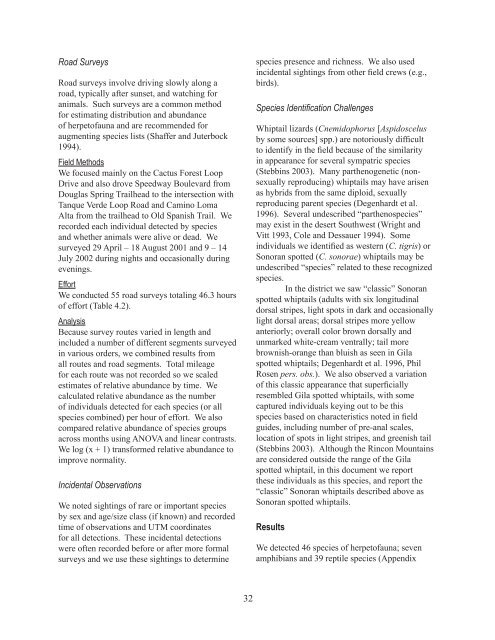Vascular Plant and Vertebrate Inventory of Saguaro ... - USGS
Vascular Plant and Vertebrate Inventory of Saguaro ... - USGS
Vascular Plant and Vertebrate Inventory of Saguaro ... - USGS
Create successful ePaper yourself
Turn your PDF publications into a flip-book with our unique Google optimized e-Paper software.
Road Surveys<br />
Road surveys involve driving slowly along a<br />
road, typically after sunset, <strong>and</strong> watching for<br />
animals. Such surveys are a common method<br />
for estimating distribution <strong>and</strong> abundance<br />
<strong>of</strong> herpet<strong>of</strong>auna <strong>and</strong> are recommended for<br />
augmenting species lists (Shaffer <strong>and</strong> Juterbock<br />
1994).<br />
Field Methods<br />
We focused mainly on the Cactus Forest Loop<br />
Drive <strong>and</strong> also drove Speedway Boulevard from<br />
Douglas Spring Trailhead to the intersection with<br />
Tanque Verde Loop Road <strong>and</strong> Camino Loma<br />
Alta from the trailhead to Old Spanish Trail. We<br />
recorded each individual detected by species<br />
<strong>and</strong> whether animals were alive or dead. We<br />
surveyed 29 April – 18 August 2001 <strong>and</strong> 9 – 14<br />
July 2002 during nights <strong>and</strong> occasionally during<br />
evenings.<br />
Effort<br />
We conducted 55 road surveys totaling 46.3 hours<br />
<strong>of</strong> effort (Table 4.2).<br />
Analysis<br />
Because survey routes varied in length <strong>and</strong><br />
included a number <strong>of</strong> different segments surveyed<br />
in various orders, we combined results from<br />
all routes <strong>and</strong> road segments. Total mileage<br />
for each route was not recorded so we scaled<br />
estimates <strong>of</strong> relative abundance by time. We<br />
calculated relative abundance as the number<br />
<strong>of</strong> individuals detected for each species (or all<br />
species combined) per hour <strong>of</strong> effort. We also<br />
compared relative abundance <strong>of</strong> species groups<br />
across months using ANOVA <strong>and</strong> linear contrasts.<br />
We log (x + 1) transformed relative abundance to<br />
improve normality.<br />
Incidental Observations<br />
We noted sightings <strong>of</strong> rare or important species<br />
by sex <strong>and</strong> age/size class (if known) <strong>and</strong> recorded<br />
time <strong>of</strong> observations <strong>and</strong> UTM coordinates<br />
for all detections. These incidental detections<br />
were <strong>of</strong>ten recorded before or after more formal<br />
surveys <strong>and</strong> we use these sightings to determine<br />
32<br />
species presence <strong>and</strong> richness. We also used<br />
incidental sightings from other field crews (e.g.,<br />
birds).<br />
Species Identification Challenges<br />
Whiptail lizards (Cnemidophorus [Aspidoscelus<br />
by some sources] spp.) are notoriously difficult<br />
to identify in the field because <strong>of</strong> the similarity<br />
in appearance for several sympatric species<br />
(Stebbins 2003). Many parthenogenetic (nonsexually<br />
reproducing) whiptails may have arisen<br />
as hybrids from the same diploid, sexually<br />
reproducing parent species (Degenhardt et al.<br />
1996). Several undescribed “parthenospecies”<br />
may exist in the desert Southwest (Wright <strong>and</strong><br />
Vitt 1993, Cole <strong>and</strong> Dessauer 1994). Some<br />
individuals we identified as western (C. tigris) or<br />
Sonoran spotted (C. sonorae) whiptails may be<br />
undescribed “species” related to these recognized<br />
species.<br />
In the district we saw “classic” Sonoran<br />
spotted whiptails (adults with six longitudinal<br />
dorsal stripes, light spots in dark <strong>and</strong> occasionally<br />
light dorsal areas; dorsal stripes more yellow<br />
anteriorly; overall color brown dorsally <strong>and</strong><br />
unmarked white-cream ventrally; tail more<br />
brownish-orange than bluish as seen in Gila<br />
spotted whiptails; Degenhardt et al. 1996, Phil<br />
Rosen pers. obs.). We also observed a variation<br />
<strong>of</strong> this classic appearance that superficially<br />
resembled Gila spotted whiptails, with some<br />
captured individuals keying out to be this<br />
species based on characteristics noted in field<br />
guides, including number <strong>of</strong> pre-anal scales,<br />
location <strong>of</strong> spots in light stripes, <strong>and</strong> greenish tail<br />
(Stebbins 2003). Although the Rincon Mountains<br />
are considered outside the range <strong>of</strong> the Gila<br />
spotted whiptail, in this document we report<br />
these individuals as this species, <strong>and</strong> report the<br />
“classic” Sonoran whiptails described above as<br />
Sonoran spotted whiptails.<br />
Results<br />
We detected 46 species <strong>of</strong> herpet<strong>of</strong>auna; seven<br />
amphibians <strong>and</strong> 39 reptile species (Appendix

















